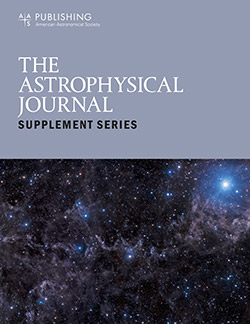使用MESA和k−ω模型的Wolf-Rayet恒星网格:从25到120 M⊙,Z = 0.02
IF 8.5
1区 物理与天体物理
Q1 ASTRONOMY & ASTROPHYSICS
引用次数: 0
摘要
为了探索大质量恒星在核心氦燃烧阶段对流核心外的超调混合和旋转混合,我们计算了一个恒星模型网格,包括旋转和非旋转的恒星模型,其中k−ω模型在Z = 0.02,覆盖了25-120 M⊙的质量范围。旋转模型以0年龄主序的旋转速率v ini / v crit = 0.4开始,计算演化直至中心碳燃烧阶段结束。采用k−ω模式的模式提供了更大的对流核和主层序宽度的拓宽。对于Z = 0.02的大质量恒星,特别是质量大于40 M⊙的恒星,f = 0.027的扩散超调模型平均更接近k−ω模型。Wolf-Rayet (WR)恒星的最终质量在9.5-17.5 M⊙和10-23 M⊙之间,分别为旋转和非旋转模型。在旋转模式中,对流核心外的C/N比在0.1以下缓慢下降,导致元素过渡区更平坦。此外,WNC相的寿命为1 ~ 4 × 10 ~ 4年,比非旋转模式长约1个数量级。WNC恒星的质量以内部混合过程为主,在核心氦燃烧阶段,氦燃烧对流核的最大质量在15 ~ 35 M⊙之间。旋转和非旋转模型的预期WNC/WR分别为0.059和0.004。本文章由计算机程序翻译,如有差异,请以英文原文为准。
Grids of Wolf–Rayet Stars Using MESA with the k − ω Model: From 25 to 120 M ⊙ at Z = 0.02
Abstract To explore overshoot mixing and rotational mixing beyond the convective core during the core He-burning phase in massive stars, we computed a grid of stellar models, both rotating and nonrotating, with the k − ω model at Z = 0.02, covering a mass range of 25–120 M ⊙ . The rotating models start with a rotation rate of v ini / v crit = 0.4 at the zero-age main sequence, and the evolution is computed until the end of the central carbon-burning phase. Models with the k − ω model provide larger convective cores and a broadening of the main-sequence width. The diffusive-overshoot models with f ov = 0.027 are, on average, closer to the k − ω models for massive stars at Z = 0.02, particularly for the stars with masses greater than 40 M ⊙ . The final masses of the Wolf–Rayet (WR) stars range from 9.5–17.5 M ⊙ and 10–23 M ⊙ for the rotating and nonrotating models, respectively. In the rotating models, the C/N ratio decreases slowly below 0.1 outside the convective core, resulting in a flatter element transition region. In addition, the lifetimes of the WNC phase are 1–4 × 10 4 yr, which is about 1 order of magnitude longer than that in the nonrotating models. The masses of the WNC stars are dominated by internal mixing processes and the maximum masses of the He-burning convective cores during the core He-burning phase are in the range of 15–35 M ⊙ . The expected WNC/WR ratios are 0.059 and 0.004 for the rotating and nonrotating models, respectively.
求助全文
通过发布文献求助,成功后即可免费获取论文全文。
去求助
来源期刊

Astrophysical Journal Supplement Series
地学天文-天文与天体物理
CiteScore
14.50
自引率
5.70%
发文量
264
审稿时长
2 months
期刊介绍:
The Astrophysical Journal Supplement (ApJS) serves as an open-access journal that publishes significant articles featuring extensive data or calculations in the field of astrophysics. It also facilitates Special Issues, presenting thematically related papers simultaneously in a single volume.
 求助内容:
求助内容: 应助结果提醒方式:
应助结果提醒方式:


